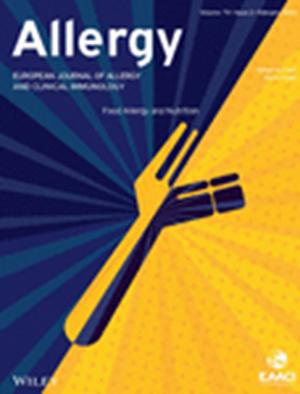Donidalorsen治疗遗传性血管性水肿的III期OASIS - HAE研究中患者报告的结果
IF 12
1区 医学
Q1 ALLERGY
引用次数: 0
摘要
背景遗传性血管性水肿(HAE)是一种罕见疾病,其特点是无法预测、经常出现严重肿胀,对患者的生活质量(QoL)造成负面影响。在 III 期 OASIS-HAE 研究(NCT05139810)中,多尼达罗生降低了 HAE 的发作率,提高了疾病控制率,改善了 QoL。方法这项双盲安慰剂对照研究将 HAE 患者随机分组,在 24 周内每 4 周(Q4W)或 8 周(Q8W)一次服用多尼达罗生 80 毫克或安慰剂。PROs包括血管性水肿(AE)-QoL问卷、血管性水肿控制测试(AECT)、患者对严重程度的总体印象(PGIS)以及工作效率和活动障碍问卷加课堂障碍问题(WPAI+CIQ)。结果90名患者接受了多尼多生Q4W(n = 45)、多尼多生Q8W(n = 23)或安慰剂(n = 22)治疗。与安慰剂组(45%)相比,多尼多生 Q4W 组(88%)的 AE-QoL 总分获得了有临床意义的改善(≥ 6 分)。从基线到第 24 周,两组患者在 AE-QoL 功能(差异:Q4W,-24.5;Q8W,-16.1)、恐惧/羞耻(Q4W,-23.9;Q8W,-20.1)和营养(Q4W,-15.7;Q8W,-10.7)方面的最小二乘均值 (LSM) 变化均大于安慰剂。与安慰剂相比,多尼多生提高了AECT评分(差异:Q4W,6.0;Q8W,4.1)。与安慰剂组相比,更多的多尼达罗森 Q4W 组患者报告疾病严重程度有所减轻(PGIS;82% 对 44%)。结论与安慰剂相比,多尼多生 Q4W 能显著改善 HAE 患者的 QoL 和其他 PROs。本文章由计算机程序翻译,如有差异,请以英文原文为准。
Patient‐Reported Outcomes in the Phase III OASIS‐HAE Study of Donidalorsen for Hereditary Angioedema
BackgroundHereditary angioedema (HAE) is a rare disease characterized by unpredictable, frequently severe swelling that negatively impacts patients' quality of life (QoL). In the phase III OASIS‐HAE study (NCT05139810), donidalorsen reduced HAE attack rate, increased disease control, and improved QoL. Here, we report further analysis of donidalorsen's impact on QoL and other patient‐reported outcomes (PROs).MethodsThis double‐blind, placebo‐controlled study randomized patients with HAE to donidalorsen 80 mg or placebo once every 4 (Q4W) or 8 weeks (Q8W) over 24 weeks. PROs included Angioedema (AE)‐QoL Questionnaire, Angioedema Control Test (AECT), Patient Global Impression of Severity (PGIS), and Work Productivity and Activity Impairment Questionnaire plus Classroom Impairment Questions (WPAI+CIQ).ResultsNinety patients received donidalorsen Q4W (n = 45), donidalorsen Q8W (n = 23), or placebo (n = 22). A larger percentage of the donidalorsen Q4W group (88%) achieved clinically meaningful improvement (≥ 6‐point reduction) in AE‐QoL total score vs. placebo (45%). Both donidalorsen groups reported larger least‐squares mean (LSM) changes from baseline to week 24 vs. placebo in AE‐QoL functioning (difference: Q4W, −24.5; Q8W, −16.1), fears/shame (Q4W, −23.9; Q8W, −20.1), and nutrition (Q4W, −15.7; Q8W, −10.7) domains. Donidalorsen improved AECT scores vs. placebo (difference: Q4W, 6.0; Q8W, 4.1). A greater proportion of the donidalorsen Q4W group reported decreased disease severity vs. the placebo group (PGIS; 82% vs. 44%). Donidalorsen Q4W showed benefits vs. placebo in the presenteeism, overall work/school impairment, and activity impairment domains of the WPAI+CIQ.ConclusionsDonidalorsen significantly improved QoL and other PROs vs. placebo in patients with HAE.
求助全文
通过发布文献求助,成功后即可免费获取论文全文。
去求助
来源期刊

Allergy
医学-过敏
CiteScore
26.10
自引率
9.70%
发文量
393
审稿时长
2 months
期刊介绍:
Allergy is an international and multidisciplinary journal that aims to advance, impact, and communicate all aspects of the discipline of Allergy/Immunology. It publishes original articles, reviews, position papers, guidelines, editorials, news and commentaries, letters to the editors, and correspondences. The journal accepts articles based on their scientific merit and quality.
Allergy seeks to maintain contact between basic and clinical Allergy/Immunology and encourages contributions from contributors and readers from all countries. In addition to its publication, Allergy also provides abstracting and indexing information. Some of the databases that include Allergy abstracts are Abstracts on Hygiene & Communicable Disease, Academic Search Alumni Edition, AgBiotech News & Information, AGRICOLA Database, Biological Abstracts, PubMed Dietary Supplement Subset, and Global Health, among others.
 求助内容:
求助内容: 应助结果提醒方式:
应助结果提醒方式:


